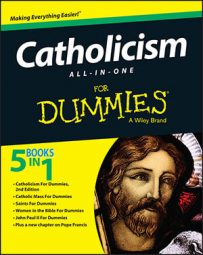According to the Catholic Church, St. John the Evangelist, the Beloved Disciple, was the youngest of the Apostles and the third to be admitted to Jesus's privileged inner circle, alongside St. James the Greater and St. Peter. He wrote the fourth Gospel and is also known as John the Divine for his lofty theology.
Galilee (first century a.d.–a.d. 100)
Patron: editors, writers, burn victims, poison victims
Feast day: December 27
John was one of the three Apostles (along with his brother, James the Greater, and Peter) privileged to witness Jesus's Transfiguration on Mt. Tabor (Matthew 17:1–6). On Easter Sunday, John raced to the tomb after hearing that Mary Magdalene discovered it empty. Out of respect for Peter's position as the leader of the Apostles, John waited outside the tomb until Peter entered (John 20:1–9).
Before the Savior died, he entrusted his mother, the Virgin Mary, to the care of John, the Beloved Disciple (John 19:27). Pious tradition holds that she lived with John in Ephesus until her Assumption in Jerusalem.
Pious tradition also asserts that after Mary's Assumption, John began his missionary expeditions throughout Asia Minor. He was arrested under the reign of the Emperor Domitian, who tried to boil him in oil. John was miraculously preserved, not only from death but also from any harm.
He was then banished to the island of Patmos in the Aegean Sea. On this island, John received personal revelations that formed the Book of Revelation or the Apocalypse, the last book of the New Testament and of the Christian Bible. He received these revelations in a cave located under the present-day monastery dedicated to his honor. John later traveled to Ephesus, where, inspired by the Holy Spirit and aided by his devoted friends, he wrote the Gospel According to St. John and the three Letters of St. John. In his letters, he addresses the Christian community as catholic, meaning "for all."
Compared to the Gospels of Matthew, Mark, and Luke, John's is much more theological and philosophical. He writes for a Christian audience and gives more substance in some areas, such as the Holy Eucharist (John 6). His symbol as Evangelist is the eagle, because he opens his Gospel with lofty ideas of preexistence: "In the beginning was the Word, and the Word was with God and the Word was God." His symbol as Apostle is a cup, with a serpent representing a failed attempt to poison him.
Because John was the youngest of the 12 Apostles, he's often depicted in sacred art as beardless, unlike the other 11. This is why, in Leonardo da Vinci's painting of the Last Supper, John, seated to Jesus's right, looks very young. John is also the only Apostle who wasn't martyred. He lived into his 90s and died of natural causes, probably in Ephesus in present-day Turkey.

